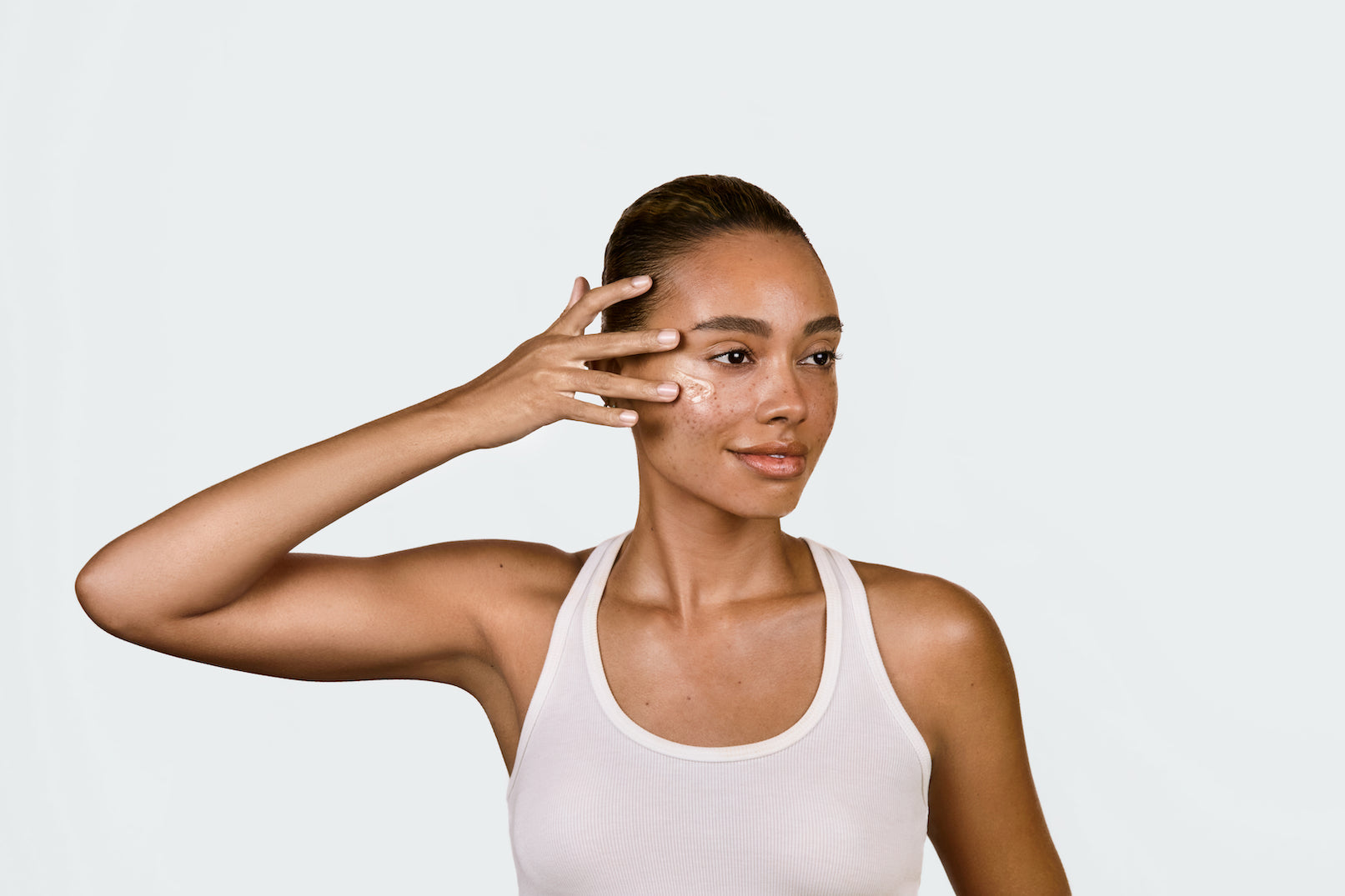

What Does Castor Oil Do For Skin?
Castor oil has become a staple in many skincare routines, thanks to its rich texture and reputation for supporting healthy-looking skin. You’ll find it in everything from moisturizers to DIY treatments, with fans praising its ability to hydrate and soothe. But what exactly does castor oil do for your skin? Let's talk about how this natural oil can fit into your routine, what benefits it may offer, what to keep in mind before giving it a try, and other ways to give your skin that glowing look.
What Is Castor Oil?
Castor oil is a thick, plant-based oil extracted from the seeds of the castor plant, known scientifically as Ricinus communis. The seeds are pressed to release a pale yellow oil that’s been used for centuries in various cultures, both for beauty and wellness purposes.
In skincare, castor oil is valued for its high content of ricinoleic acid, a unique fatty acid that gives the oil its signature moisturizing and soothing qualities. Its dense, almost sticky texture makes it especially popular for locking in moisture and creating a protective barrier on the skin’s surface.
Beyond skincare, castor oil is a versatile ingredient found in hair care products, massage oils, and even some makeup removers. Many people use it to help soften cuticles, condition lashes and brows, and add shine to hair. In wellness routines, castor oil is sometimes used in traditional remedies and massage practices for its comforting, warming feel.
Because it’s naturally derived and free from added fragrances or dyes, castor oil appeals to those looking for simple, gentle options in their beauty routine. Whether you’re applying it directly to your skin or blending it with other oils, castor oil’s rich, nourishing properties make it a go-to for anyone seeking a more hydrated, soothed appearance.
Key Benefits of Castor Oil for Skin
Moisturizing Properties
Castor oil is well known for its ability to lock in moisture, thanks to its high concentration of ricinoleic acid—a fatty acid that acts as an effective humectant. Humectants draw moisture from the air into your skin, helping to keep it hydrated and soft. The thick texture of castor oil also creates a protective barrier, which helps prevent water loss from the skin’s surface. This makes it especially helpful for dry or rough areas that need extra hydration.
Supports Healthy-Looking Skin
Regular use of castor oil can give your skin a smoother, more hydrated appearance. Its emollient properties help soften the skin and improve its texture, making it look and feel healthier. The nourishing fatty acids in castor oil support the skin’s natural barrier, which can help maintain a supple, radiant look.
May Help Reduce the Appearance of Pimples
Castor oil contains ricinoleic acid, which has been shown to have antimicrobial properties. This means it may help reduce the appearance of pimples by supporting a clearer-looking complexion and helping to keep the skin’s surface balanced. While it’s not a substitute for targeted acne treatments, some people find that castor oil helps calm the look of occasional zits.
Soothes the Look of Irritated Skin
The gentle, calming effects of castor oil can be especially comforting for sensitive or stressed skin. Its rich fatty acid content helps reduce the look of redness and irritation, making it a popular choice for soothing the appearance of minor skin discomfort.
How To Use Castor Oil on Your Skin
Before adding castor oil to your routine, it’s important to make sure your skin responds well to it. Here’s how to safely and effectively use castor oil for your skin:
Patch Testing and Safety Tips
Always start with a patch test to check for sensitivity. Apply a small amount of castor oil to a discrete area, like the inside of your wrist or behind your ear. Wait 24 hours and watch for any signs of redness, itching, or irritation. If your skin stays calm, you can move forward with using it on your face or body.
Choose a pure, cold-pressed castor oil that’s free from added fragrances or dyes. This helps reduce the risk of irritation, especially if you have sensitive skin.
Step-by-Step Guide for Applying Castor Oil
-
Cleanse Your Skin: Start with clean, dry skin to help the oil absorb better.
-
Warm the Oil: Pour a few drops of castor oil into your palm and gently rub your hands together to warm it up.
-
Apply Sparingly: Dab a small amount onto your fingertips and gently massage it into your skin, focusing on dry or rough areas. For your face, use a thin layer to avoid a heavy, greasy feel.
-
Let It Absorb: Allow the oil to soak in for several minutes. If your skin feels too oily, you can blot away any excess with a soft cloth.
-
Use at Night: Many people prefer to use castor oil as part of their nighttime routine, since it’s rich and takes time to absorb.
Tips for Mixing Castor Oil With Other Skincare Products
Dilute With a Lighter Oil: If castor oil feels too thick, mix it with a lighter oil like jojoba or almond oil. This makes it easier to spread and can help balance the texture, especially if you’re applying it to larger areas like your cheeks or forehead.
Blend Into Moisturizer: Add a drop or two of castor oil to your regular moisturizer for an extra boost of hydration. This is a great way to introduce castor oil into your routine without overwhelming your skin, and it helps lock in moisture as the final step in your regimen.
Avoid Mixing With Strong Actives: Don’t combine castor oil with products containing strong acids or retinoids in the same routine, as this can increase the risk of irritation. Instead, use castor oil on nights when your routine is focused on hydration and soothing.
Spot Treatment: For targeted care, use castor oil as a spot treatment on dry patches or areas that need extra soothing, such as around the nose, on the chin, or wherever your skin feels rough.
Use in Night Routine: For best results, apply castor oil as the last step in your nighttime skincare routine, after serums and moisturizers. This allows the oil to seal in all the hydration and benefits from your previous products, leaving your skin feeling soft and nourished by morning.
Can Castor Oil Help With Acne-Induced Inflammation?
Castor oil contains ricinoleic acid, which has natural soothing and moisturizing properties. Some people find that applying a small amount of castor oil can help calm the look of redness and irritation that often comes with pimples. Its gentle texture can create a comforting barrier on your skin, supporting a more balanced, hydrated appearance. However, castor oil is quite rich, so if you’re prone to clogged pores, it’s best to use it sparingly and always patch test first.
While castor oil can support the look of calmer skin, it’s not a targeted solution for acne or the inflammation that often follows. If you’re looking for a more advanced way to address acne-induced inflammation, the Bye Acne Pro Kit is a smart choice.
This kit features the FDA-cleared Bye Acne 3-Minute Light Therapy Spot Treatment device, which combines both Blue Light and Red Light Therapy to target mild-to-moderate acne and inflammation in just three minutes per spot.
Blue Light Therapy helps eliminate acne-causing bacteria and reduce excess oil, while Red Light Therapy helps reduce the appearance of inflammation and redness, supporting clearer, healthier-looking skin.
For added post-treatment care, the kit also includes Serum-Infused Microdart Patches. These protective hydrocolloid patches absorb impurities while delivering soothing ingredients like niacinamide, gotu kola, madecassoside, and green tea to calm and comfort the skin after treatment. The two-step routine is pain-free, non-invasive, and easy to use at home or on the go, making it a convenient option for anyone seeking visible results and a more balanced complexion.
Conclusion
Castor oil has earned its place in many skincare routines for its ability to support a more hydrated, soothed, and healthy-looking complexion. Its rich texture and natural fatty acids make it a versatile choice for those seeking gentle care, whether you’re addressing dryness, irritation, or the appearance of pimples.
If you’re exploring ways to calm and comfort your skin, consider adding castor oil to your routine—always starting with a patch test to ensure it’s right for you. And remember, there are plenty of gentle, effective options available to help your skin look and feel its best.
Sources:
-
Emollients: Creams, Soaps, Moisturizers, Ointments, Benefits
-
Essential Fatty Acids and Skin Health | Linus Pauling Institute | Oregon State University






















